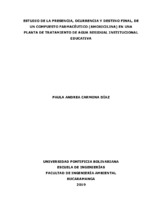| dc.contributor.advisor | Cerón Vivas, Alexandra | |
| dc.contributor.author | Carmona Díaz, Paula Andrea | |
| dc.coverage.temporal | 2019 | |
| dc.date.accessioned | 2020-11-19T13:07:47Z | |
| dc.date.available | 2020-11-19T13:07:47Z | |
| dc.date.issued | 2019-05 | |
| dc.identifier.uri | http://hdl.handle.net/20.500.11912/6410 | |
| dc.description | 103 páginas | spa |
| dc.description.abstract | Las plantas de tratamiento de aguas residuales (PTAR) convencionales no se consideran diseñadas para la eliminación de compuestos farmacéuticos, siendo liberados a los cuerpos de agua superficiales, por lo tanto, se determinó la existencia, ocurrencia y destino de la amoxicilina en la PTAR-UPB. Se cuantificaron las concentraciones en el afluente, efluente de los Reactores Anaerobios de Flujo Pistón y el efluente final, a través de Cromatografía Líquida de Alta Resolución. Se realizó una correlación estadística para determinar la influencia de las precipitaciones en el consumo de este medicamento, y la relación entre la eficiencia de remoción y los parámetros fisicoquímicos. El destino de este compuesto a lo largo del proceso de tratamiento fue evaluado a través del cálculo de balances de masas. La concentración detectada en el afluente fue de 244 ng/L, 202 ng/L en el efluente RAP y 198 ng/L en el efluente. Se encontró una correlación moderada entre las precipitaciones y el consumo de la amoxicilina. El tratamiento secundario presentó una mayor remoción por degradación que el tratamiento terciario. Además, la eficiencia de remoción global de degradación estuvo alrededor del 35,26%, el restante puede permanecer en fase acuosa o ser absorbido por el buchón de agua. La eficiencia de remoción de DBO5 y STV presentó alta correlación de 0,88 y 0,69, respectivamente, mientras que, para DQO, NTK, ST, SST y SSV, se presentó baja correlación. Las concentraciones encontradas difieren respecto a estudios en PTAR municipales, debido a la poca dilución y alto consumo de amoxicilina que no se relaciona con las precipitaciones por la ubicación geográfica de Colombia y a los diversos usos de este medicamento. De acuerdo, a sus propiedades fisicoquímicas, el principal mecanismo de eliminación es la degradación, por eso la UPB se puede considerar como una fuente puntual de CF hacia la quebrada Mensulí. | spa |
| dc.description.abstract | Conventional wastewater treatment plants (WWTP) are not designed for the elimination of pharmaceutical compounds, being released to surface water bodies, therefore the existence, occurrence and destination of amoxicillin in the WWTP - UPB was determined. The concentrations of this compound in the affluent, Anaerobic Flow Piston Reactors effluent and final effluent were quantified through High Resolution Liquid Chromatography. A statistical correlation was made to determine the influence of rainfall on the consumption of this drug and the relationship between the removal efficiency of amoxicillin and the physicochemical parameters. The fate of this compound along the treatment train was evaluated through the calculation of mass balances. The concentrations detected in the affluent was 244 ng / L, 202 ng/L in the RAP effluent and 198 ng/L in the effluent. A moderate correlation was found between precipitations and the consumption of Amoxicillin. The secondary treatment showed greater degradation removal compared to secondary — tertiary treatment. In addition, the overall removal efficiency of degradation was close to 35,26%, the rest of amoxicillin can remain in the aqueous phase or be absorbed by the water batch in the tertiary treatment. The removal efficiency of BOD5 and SW presented a high correlation of COD, NTK, ST, SST and SSV low correlation was presented. The concentrations found differ from studies in municipal WWTP, due to the low dilution and high consumption of amoxicillin that is not related to precipitation due to the geographical location of Colombia and the different uses of this drug. According to its physicochemical properties, the main elimination mechanism is degradation, which in why the UPB can be considered as a point source of CF at Mensul 1 brook. | eng |
| dc.format.mimetype | application/pdf | |
| dc.language.iso | spa | |
| dc.publisher | Universidad Pontificia Bolivariana | spa |
| dc.rights | Attribution-NonCommercial-NoDerivatives 4.0 International | * |
| dc.rights.uri | http://creativecommons.org/licenses/by-nc-nd/4.0/ | * |
| dc.subject | Amoxicilina | spa |
| dc.subject | Aguas residuales | spa |
| dc.subject | Escuelas | spa |
| dc.subject | Compuestos farmacéuticos | spa |
| dc.subject | Plantas para tratamiento de agua | spa |
| dc.title | Estudio de la presencia, ocurrencia y destino final, de un compuesto farmacéutico (amoxicilina) en una planta de tratamiento de agua residual institucional educativa | spa |
| dc.type | Trabajo de grado | spa |
| dc.publisher.department | Escuela de Ingenierías | spa |
| dc.publisher.program | Ingeniería Ambiental | spa |
| dc.type.hasVersion | publishedVersion | spa |
| dc.description.sectional | Bucaramanga | spa |
| dc.description.degreename | Ingeniero Ambiental | spa |


